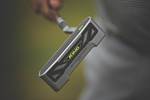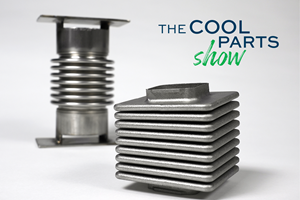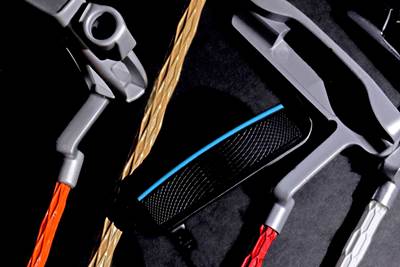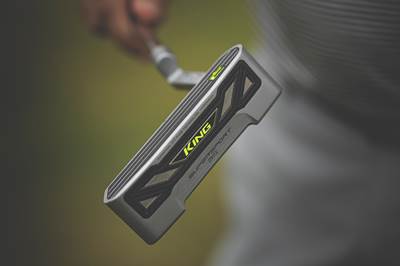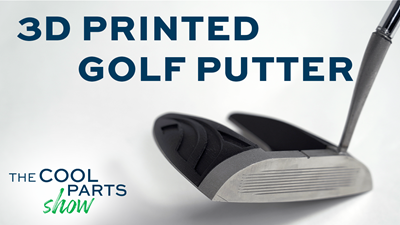Scroll to unlock this premium content if video does not play.
Forgiveness in a golf club refers to how well the club compensates for a less-than-ideal swing. Performance-enhancing clubs with greater forgiveness are typically larger, in order to spread around the area of ideal contact known as the “sweet spot.” Cobra Puma Golf’s Limit3D iron accomplishes this same feat but within a smaller, more compact head. The key is discretionary weight: The club head is made with internal lattices produced through laser powder bed fusion that enable Cobra to remove material for the sake of reintroducing the missing weight with heavier tungsten inserts. The tungsten sits near the bottom of the club, lowering its center of gravity and providing a more forgiving playing experience. Additive Manufacturing Media brand VP and former golf pro Rick Brandt joins us for this episode. | This episode of The Cool Parts Show is sponsored by Carpenter Additive
The Cool Parts Show is a video series from Additive Manufacturing Media that explores the what, how and why of unusual 3D printed parts. Watch more here.
Have a cool part to share? Email us.
Related Resources
- More on the Cobra Super Sport 35 putter, made with a different 3D printing process: binder jetting.
- A different golf club head concept, with exchangeable weights on the exterior.
- How weight distribution matters for golf putter shafts, and how AM can help here, too.
- Other examples of 3D printed sporting goods.
Transcript
Pete Zelinski
I'm Pete.
Stephanie Hendrixson
I'm Stephanie, and this is The Cool Parts Show, our show all about innovative 3D printed parts.
Pete Zelinski
Additive manufacturing for sporting goods is something we've covered on the show before.
Stephanie Hendrixson
But this club is different. It is a production part, it is a commercially available product, and it is approved for professional use.
Pete Zelinski
This club has a special geometry on the inside that delivers a performance improvement golfers wouldn't expect from a club this size and shape.
Stephanie Hendrixson
If you think you know the story behind Cobra's latest 3D printed iron. Stay tuned. We've got the engineering story.
Pete Zelinski
How additive manufacturing is changing golf clubs on this episode of The Cool Parts Show.
Stephanie Hendrixson
This episode of The Cool Parts Show is brought to you by Carpenter Additive. The company's PowderLife Solution is a combination of hardware and software technologies designed to help AM users manage their metal powders. Stay tuned after the episode for more on how the system works.
Pete Zelinski
Welcome to The Cool Parts Show.
Stephanie Hendrixson
If you like what you see, make sure to subscribe to our channel on YouTube. You can also sign up for our All Access email to get notified about our new episodes even earlier.
Today on the show, we are talking about the Cobra Puma Golf Limit3D iron. This is a golf club that came to market earlier this year. With a head that is made through metal 3D printing, specifically laser powder bed fusion.
Pete Zelinski
This club looks just like an iron that a professional golfer would use. It weighs the same as a conventional iron, but thanks to additive manufacturing and the changes that it brought to this club, it is much easier to hit a great shot with this club than with a conventional iron. Cobra Puma golf has been using additive manufacturing for a while.
There was an earlier 3D printed product, a putter. That one was made of binder jetting. We actually covered that when they brought it out. And we'll put a link in the show description. That was, among other things, kind of an exploratory project figuring out additive manufacturing for production. As far as fully leveraging the potential of additive manufacturing for a significant design change, significant performance improvement. This club is a striking example of that.
So to hear more about this club, more about the company's journey with additive manufacturing, here is Cobra Puma Golf's director of innovation Ryan Roach.
Ryan Roach
We chose to develop the Limit3D irons because we felt that there was a hole in the market and we thought with additive, we could fill that hole.
Golfers want to play what the pros play, but they're not as good as the pros. So they have to play clubs that are designed differently. And in doing so, some of the attributes that golfers want to have that relate to that pro club are no longer there. So you have to make a club bigger and it has to move the weight around. It doesn't look as good as and feel as good, but it's easier for someone to hit.
With additive, we felt we could capture the best things that golfers want about a club that the pros will play, such as the look and feel at impact, and combining that with the forgiveness and performance that a game improvement club would have. And that's something that quote, pundits in the industry said, “That's just not possible.”
Stephanie Hendrixson
So Ryan brings up this tension balancing the size of the club versus its forgiveness. A professional golfer is more likely to use a club that looks like this, that's smaller, maybe offers better control, higher launch, greater distance. Whereas other golfers might choose a club that's bulkier than this but makes it easier to hit the ball.
So I don't golf. I don't think you do very much either, Pete. So for this episode, we consulted a colleague who knows golf a lot better than we do.
I want to introduce the brand vice president for Additive Manufacturing Media, which produces this show. His name is Rick Brandt. And in a past life, he was a golf pro, somebody who does equipment fittings and teaches golf in a club setting.
Rick Brandt
I left the golf industry in early 2000, and at that time, I was managing a high-end daily fee golf club, which was the commercial operations, the, tournament events. I was teaching and also doing club fittings, which was typically intertwined with giving golf lessons.
So a standard set of golf clubs is 14 clubs, and that's made up of woods, irons and a putter. The predominant volume of clubs in your bag are irons. Typically a person that is anywhere from 8 to 11 irons in their bag. And the purpose of an iron, these are for your more precision golf shots. So these are usually approach shots to the green or shots, when you're hitting into a par three.
So the goal of every golfer is to hit the golf ball in the sweet spot. And that's essentially the bullseye of the clubface. And forgiveness in a golf club is consistency when the ball is struck outside of the sweet spot area.
If you hit a golf ball more towards the toe, more towards the heel a club tends to twist. There's vibration. And as you move further and further from the sweet spot, even in small amounts of a quarter of an inch to a half an inch, it greatly affects, one, the distance that a golf ball goes. So you can see distance dropping off of 10 or 15 yards, but it also imparts sidespin and directional inconsistencies as well as it's a harsh feeling that you get back from the golf club.
So if you've ever experienced swinging a baseball bat and hitting the ball near the handle of the bat or, some people with a tennis racket where you hit the ball towards the frame or towards the handle, you get this harsh vibration.
Hitting the ball in the sweet spot is one of the greatest feelings in golf, and you don't get that vibration and harsh impact.
Pete Zelinski
So how to get that sweet spot feeling? Couple options. There are game improvement clubs that look different than this, different geometry that spread that sweet spot region around. And by contrast, there are clubs, conventional clubs look just like this, but they are made through forging so that the clubhead is a solid piece of steel and the sweet spot is very targeted, very localized.
And so how do you get a club just like this and spread the sweet spot around to get that forgiveness? And the solution is not so much a matter of lightweighting, which we talk about a lot on this show, but it's more a matter of reweighting, spreading the weight around within this geometry.
Ryan Roach
Discretionary weight in terms of golf design is, weight that is not needed to create the basic structure that would be durable. In the case of an iron you need a face. You need a sole. You need something to put the shaft into. We call that the hosel area. And you need a certain target weight over that head in order to create the balance of the club that you need.
And so there's a spec for that weight, let's call it 270 grams. Everything that you can take out that isn't necessary for that durability piece. is now discretionary for the designer to put wherever they want to in the design in order to create the mass properties that we want for that clubhead.
So we want it low CG. We're going to take that extra weight and slam it all the way to the bottom of the club. If we want to have something that's very forgiving. We're going to push that weight out to the outside of the clubhead. So we're always chasing for the ability to have as much of that as possible.
Stephanie Hendrixson
So discretionary weight, the weight that the designer has the freedom to play around with, up to and within the limits of the manufacturing process. So forging is going to impose certain design limitations. Casting might give you a little bit more freedom. But the great advantage that Cobra found with additive manufacturing was the chance to really take control of where that discretionary weight goes.
And the solution that they found was actually to remove a lot of it with 3D printing and fill most of this clubhead with lattices.
Ryan Roach
The cool thing about the Limit3D iron is with that internal lattice structure, we can take something that was solid and, pull all that extra weight out and replace it with lattice. And that's the discretionary weight that the Limit3D iron has that other clubs don't. And so that way we can take that weight and concentrate it in this case low down in the heel and toe of the clubhead.
Pete Zelinski
So again, not lightweighting, but reweighting. The club is made through laser powder bed fusion of 316 L stainless steel and the overall net weight remains the same as a conventional club. So that means all of that weight that is taken out by replacing what used to be solid steel with open lattice forms inside of that club, the weight has to be added back in somehow, somewhere else, and that happens during postprocessing.
We won't talk about postprocessing much in this episode because as it happens, most of the post-processing steps are the same for an additive club or a conventional club, plating for example. But one postprocessing step that is added here is the insertion of heavy tungsten inserts. Tungsten, heavier than steel, inserted to compensate for balance the weight that was lost through the lattice geometry. The effect is to move the center of gravity of this club much closer to the ground, and that is a huge factor in realizing this club's greater forgiveness.
Stephanie Hendrixson
When you put it that way, like it sounds like kind of a straightforward problem, take the weight out, put it back in. But as they were figuring out how to do this, they had to be careful to maintain the stiffness and the strength of the outside of the clubhead. And it turned out that getting to just the right lattice was kind of tricky. It turned into an engineering problem and also a little bit of a computational problem.
Ryan Roach
When it came time to design the inside of the head with the internal lattice, we found that we were really getting into a bottleneck with the files. It was almost like debilitating, I would say.
In other words, a file would slow down so much that you'd try to make one change and you'd have to wait and wait and wait. And so maybe it's a limitation of the software, maybe it's a limitation of our computing power, but that's why we searched for other tools that could do this better. And we landed eventually on nTop as being, the best tool to design that internal lattice. So we had the outside shape done with NX, and then the inside geometry we used nTop and its lattice in capability and, and its lattice analysis capability to create the internal geometry.
nTop has a built-in suite of lattice types, that we were looking at. And we started with a body centered cubic lattice. It's very lightweight. That was our starting point. And then as we analyzed things and made parts to test, we found out that we needed something that was stiffer, and stronger. So our journey ended up from the, you know, through several different lattice types, to a dodecahedron lattice.
Rick Brandt
So I think it's important to understand that additive manufacturing, the process itself, is not what makes this iron so special. It's the design capabilities that additive manufacturing allowed. So inside this golf club you have a hollow lattice structure, which is very similar to when wood driver heads got oversized back in the mid-90s and you have a hollow head. You've condensed this technology into a small iron head, which is incredibly forgiving and a game-enhancing club for golfers of any skill level.
So I was thoroughly impressed with this club. I mean, I was fortunate to be in the golf industry in the mid-to-late 90s when large oversize drivers came out, which I think changed the game for many players. This is the next advancement in technology that I've seen that matches that.
I would say for me it was like mentally confusing because when you look down, you see this beautiful club. It looks like a forge blade, but it performs like a large cavity back, forgiving cast iron. It's an amazing advancement in golf technology.
Pete Zelinski
For Cobra this is just the beginning. Ryan talks about how within the company, with the realization of this iron, the view of additive manufacturing has really changed. particularly among the engineers who will be realizing future transformative re-engineered products.
Ryan Roach
Within our walls of our company, the attitude has changed quite a bit. One of the things that I think that made the Limit3D irons so successful was that it wasn't a solution in search of a problem, it was a technology applied to solve a problem.
And in this case, it was kind of we call it an unspoken need. But sometimes that that's okay, as long as there is something, a gap that it's filling, it's either solving a problem that exists that everybody knows about, or it's bringing something new that no one possibly thought was possible.
And I think we're going to continue to look at, using additive to make sure it satisfies one of those criteria. It's solving a problem or it's filling a gap that was there.
Stephanie Hendrixson
As the name suggests, the Limit3D iron was produced in an initial run of 500 sets. And we should say that in the development of this club, Cobra worked with collaborated with the U.S. Golf Association as well as the Royal and Ancient Golf Club in the UK to ensure that these irons were going to adhere to their regulations to meet the standards for competition, and in fact, Limit3D irons were used by at least one pro golfer in this year's British Open. Probably more to come.
And Cobra is going to continue to look for these opportunities. As Ryan says, they're going to be looking for places where additive manufacturing can let them bring a club, bring an option to market that golfers haven't had before.
Pete Zelinski
Let's recap. This is the Cobra Puma Golf Limit3D iron. Looks just like a conventional forged iron. Same shape, same dimensions. The difference is on the inside. It's made through laser powder bed fusion. To achieve a carefully engineered lattice form on the inside for weight removal from the club. But that weight removal is compensated to keep the weight. The same with tungsten inserts that move the center of gravity lower.
Stephanie Hendrixson
What makes this club so cool is this idea of discretionary weight. Designers have been limited with what they can do as far as moving weight around, but now with 3D printing, Cobra found this way to take the weight out, put it back where they wanted it, and get exactly the performance, exactly the way they wanted this club to play.
Pete Zelinski
The company learned other lessons about additive manufacturing more directly related to engineering and production, and they applied those lessons learned in order to succeed with the manufacturing of the Limit3D iron.
Our All Access members got to hear Ryan talk about that additive manufacturing lessons learned that they've carried forward. If you would like to hear that, it's easy. joining All Access is free. It's simple to sign up. TheCoolPartsShow.com/AllAccess.
Stephanie Hendrixson
And if you have a cool part that you'd like to see featured, we'd love to hear about it. Please email us. CoolParts@AdditiveManufacturing.media.
Pete Zelinski
Thank you for watching.
Stephanie Hendrixson
Thank you to our sponsor Carpenter Additive. In addition to supplying metal powders, the company also offers services, software and hardware to help AM users manage their powder. One example is the PowderLife System, a combination of cloud-based tracking software with hardware designed to make powder handling easier.
Stephanie Hendrixson
Two key components are the PowderLife Hopper and the automated docking station. Luke Boyer, manager of PowderLife Applications and Andrew Holliday Applications engineer, explain how the system works.
Luke Boyer
Today, when a user of additive manufacturing is receiving powder, they oftentimes receive it in either five-, ten-, 15-, maybe a 20-kilo bottle. But they're receiving pallets of them and they're receiving ten, 20, 50, 100s of these bottles.
The user has to look and segregate and store them appropriately so the bottles don't get mixed up. And it requires a lot of lifting and moving and labor.
Andrew Holliday
The components of PowderLife are all based around making the powder management systems on the additive manufacturing shop floor easier to use for the operator, cleaner, as well as more traceable.
Three of those basic parts of PowderLife are our PowderLife hoppers or our storage containers for powder. The second would be automated docking systems that allow material to be pushed in and out of machines with no human contact. The third would be our PowderLife Online software system that allows you to trace this powder as it goes through your shop floor.
Luke Boyer
The hardware and the software together just helps really streamline that and improve the final user's experience and let them concentrate on going from design to the part itself. It takes the headache of powder management out of the equation for them.
Related Content
Additive Manufacturing Is Subtractive, Too: How CNC Machining Integrates With AM (Includes Video)
For Keselowski Advanced Manufacturing, succeeding with laser powder bed fusion as a production process means developing a machine shop that is responsive to, and moves at the pacing of, metal 3D printing.
Read MoreVideo: How Multimaterial Laser Powder Bed Fusion Works
Penn State University’s CIMP-3D is exploring applications of the Schaeffler Aerosint system for multimaterial 3D printing. During a recent visit, I got an introduction to this system.
Read MoreVulcanForms Is Forging a New Model for Large-Scale Production (and It's More Than 3D Printing)
The MIT spinout leverages proprietary high-power laser powder bed fusion alongside machining in the context of digitized, cost-effective and “maniacally focused” production.
Read MoreFlexible Bellows Made Through Metal 3D Printing: The Cool Parts Show #64
Can laser powder bed fusion create metal parts with controlled flexibility? We explore an example in this episode of The Cool Parts Show.
Read MoreRead Next
3D Printed Golf Putter Shafts: AM Tailors Weight Distribution for an Optimized Putting Stroke
Snarr3D offers high-performance golf putters with aesthetic features made possible through 3D printing. In manipulating the weight distribution of the golf putter shaft, Snarr3D aims to enhance accuracy and performance to give golfers the equipment suited to their individual game.
Read MoreMore Than Meets the Eye to Cobra’s 3D Printed Putter
Cobra Golf drew attention in November 2020 with the launch of a limited-edition putter with metal 3D printed head. What this club says about product development, reshoring manufacturing and the future of consumer goods.
Read More3D Printed Putter Tailored to the Golfer: The Cool Parts Show #49
An engineering student in South Africa used metal and polymer 3D printing in tandem to create a putter customized to the individual golfer’s swing.
Read More

.jpg;width=70;height=70;mode=crop)

